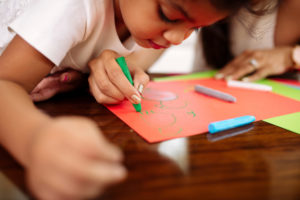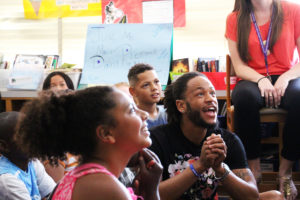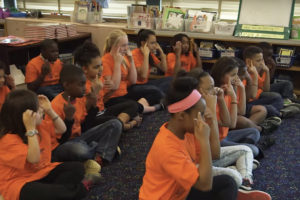A Center for Healthy Minds team recently discovered that a video game developed for research may hold promise for increasing empathy in some kids, as demonstrated by changes in underlying brain networks associated with empathy.
Video games aside, however, there are plenty of ways to instill empathy in kids of all ages, and the vast majority can be done with no additional resources or cost.
The study’s lead researcher Tammi Kral from the Center and mindfulness expert Chad McGehee offer some tips for training empathy in middle school age adolescents.
But First, Some Background on Empathy
When we talk about empathy in middle schoolers and teens, there are a few facts to consider, the first being that this age group empathizes differently than adults. In a recent study, Kral and researchers deepened what we know about these differences. While prior research showed that adults are able to accurately empathize using brain networks that support both perspective-taking (“I understand why you might feel that way”) and sharing emotions (“I feel what you’re feeling”), teens are more effective when they rely on brain networks that support perspective-taking forms of empathy instead of emotional forms.
In other words, when kids are accurate in empathizing with another person, they are more likely to understand why someone might feel a certain way, but less likely to embody the emotional states of the person they’re relating to.
“We found that adolescents are using the perspective-taking network in the brain when they are accurately identifying the emotions of another person,” Kral says. “But when they share emotional experience, they are less accurate. This was surprising for us.”
Though scientists aren’t exactly sure why kids empathize differently, they have some theories. Kral says one reason may be that areas associated with self-regulation in the brain are still developing in adolescents, and that such regulation is necessary to offset the personal distress someone may experience when emotionally empathizing with another person.
Data suggest that a lack of empathy among youth is a serious problem. According to the National Center for Education Statistics, more than one fourth of U.S. students say they have been bullied at school, where the most common types are verbal and social bullying. Finding ways to promote healthy emotional development during this time period matters, especially since adolescence is important in shaping mental health into adulthood.
Empathy Tips for Youth
Scripts/activities to be led by educators or caring adults. Many of these tips are integrated in other social emotional learning curricula. Center expert Chad McGehee shares ways to use these with kids.
Tip 1: Recognizing the Rise and Fall of Our Thoughts and Emotions
Paying attention to the ever-changing nature of their own thoughts and emotions may help youth and teens to understand others’ experiences and empathize with others’ emotions and behaviors accordingly. One way to describe this process to teens is with “Mind-Body Jars.” These are hand-sized globes comprising a liquid solution and glitter, similar to a snow globe, and provide a tangible lesson on the nature of our thoughts and emotions. We can shake the globes to see the glitter circulate and swirl in commotion, which may be how teens are feeling when they are experiencing strong emotions. Then, we allow the jar to be still and witness the particles falling and settling to the bottom of the globe. Our experience of thoughts and emotions can be much the same. We may experience a flurry of thoughts, emotions and sensations, but with a little time, space and awareness, the commotion often settles all on its own.
You can ask the exploratory questions: What do our emotions look and feel like in our experience/in our own minds and bodies? Where do you feel the emotions in your own body? How do the feelings in your body change? How might those emotions look and feel differently in other people?
Tip 2: Acting Out Emotions Together
Emotion charades can be fun and also grow empathy in this age group. In a Center study with 5th graders, experts asked students to act out an emotion and others had to guess what that emotion was. It’s fascinating to see similarities yet distinct differences between students. What might look angry to one person might actually be the actor expressing a completely different emotion. We typically understand others’ emotions based on our own histories and how we experience them ourselves. This practice underscores the reality that we may think we know what others are feeling when in fact we don’t. When we focus on how emotions feel in our own bodies, it is often a helpful way to get at what another person might be feeling. However, we may need to remind ourselves that our perceptions may not align with reality, and then remind ourselves of the need to ask. From this place of curiosity and care, we can often find a way to connect with others.
Tip 3: Supportive Attitudes During Teamwork
We’ve discovered that people’s responses to their own mistakes and the mistakes of others is just as – if not more – important than succeeding in the task at hand. We’ve done a practice with kids of various ages, where as a group, they are asked to stand in a circle and pass a bell without allowing it to ring. Students are not only instructed to be present with their own bodies and sensations, but they also get to experience firsthand how quickly their own turn handling the bell shifts into someone else’s turn. Students are aware of the anticipation, the actual passing of the bell and the period right after they pass it. This awareness allows student to immediately identify what another student may be experiencing since they just went through it.
Encouraging supportive language is critical. If someone doesn’t succeed in the task at hand, sharing words of encouragement and validating that it’s OK and could have happened to anyone is important.
Tip 4: Caring/Kindness Cards
Intentionally cultivating empathy by offering well wishes for others in a group setting can help, too. In addition to becoming more familiar with our own emotions, we grow empathy and compassion for others and ourselves.
To begin, it can be helpful to take some time to reflect and discuss a few guiding questions: What does it mean to you to feel safe? What does it mean to you to feel happy? How about healthy? And peaceful? Do you think we all want to feel safe? Happy? Peaceful? Remember during this discussion to be aware of the feelings and sensory experience in the body of talking about your experiences of being safe, healthy and peaceful.
The next step is to notice how it feels when others wish you to be safe, healthy and at peace. It involves the passing of cards with well wishes on them. Cards may say things like, “May you experience the joy of feeling safe, happy and calm;” “May you have the strength, courage and patience to meet the challenges in life;” “May you have love, peace and kindness in your life.” With students sitting in a circle, give one card to each student that is a wish from the teacher to the student.
Take a moment to review the message on the card and share how it feels to receive this message. Then, ask students to close the card and pass it to the person to their right. Share with students that they are now sending this wish to someone right next to them and that it’s OK to do because we know that each of us wants to feel safe, we want to feel happy, we want to be healthy and we want to feel peaceful. Continue to check in about what it is like to send the wishes and what it is like to receive the wishes.
Tip 5: Compassion Circles
This next tip relates to compassion, which is similar to empathy but different in that it focuses instead on acting in ways to relieve the suffering in others. Feelings of empathy can shift to compassion when we take our understanding of others and send them wishes to be well or behave in ways to reduce their suffering.
This practice is best told by Center founder and director Richard Davidson, who describes it in a blog post he wrote for the Momentous Institute:
“This exercise includes asking a group of kids to form circles based on their answers to simple questions like “Do you own a pet?” or “What’s your favorite color?” Students mix and converse with classmates they might not have known much about, encouraging them to relate differently to one another, to remove a sense of “otherness” that tends to block compassion.
I’ll never forget hearing from one of our education experts what happened when students were asked to form a circle based on their answer to the question, “Have you ever felt left out or bullied?” Nearly everyone came to the circle, and one young girl who consistently felt this way commented that she didn’t know others felt this way too. It brought her to tears to know she wasn’t alone, and it created a moment of shared compassion and appreciation for one another’s vulnerability among the students and instructors.
This expansion of relating with others is at the heart of another way we can reconnect with compassion through what we call “compassion” or “loving-kindness” meditation. In these practices, we intentionally recognize our innate basic goodness and acknowledge that all humans share this same capacity. Compassion meditations often involve bringing to mind a beloved family member, friend or pet, and cultivating your love for them, and then expanding those same feelings to others you know, people you struggle relating to, and eventually strangers in your community and the world. The practice typically includes silently repetition of phrases like, “May you be happy, may you be healthy, may you live with ease.”






